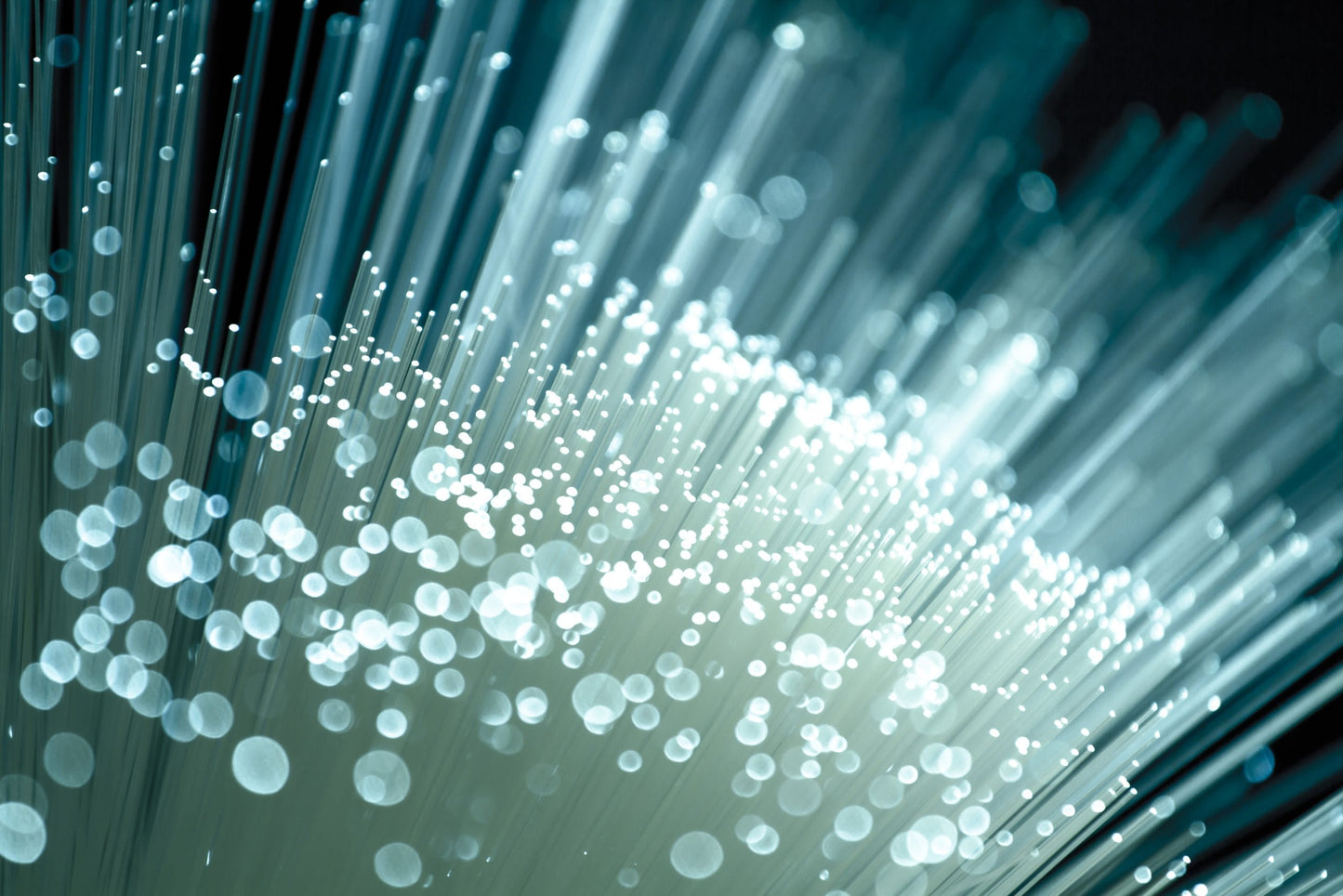
The most pressing issue at this time is the proposed “phasing out” of pre-existing wired infrastructure that is capable of connecting each home and business directly to the internet (without wireless companies as middlemen), and bypassing all the weaknesses and inefficiencies of wireless. I am referring to high-tech landlines made of advanced copper cable and fiber optic, which provide the fastest and most reliable connectivity of any technology available, and will always be faster and better than wireless. If this is new information to you, and you don’t understand why wired will always be faster and better no matter what new wireless tech is developed, read on.
The wireless industry claims that their technology is “of the future”, and wired infrastructure is outdated, less powerful and capable, and is not adequate for society’s future. This is nothing more than an advertising gimmick, and not remotely truthful. When critically evaluated, it is clear that the function of wireless is best suited as a peripheral adjunct, mainly for portability, to a basic localized wired infrastructure to every home and business.
The weaknesses of wireless are the strengths of wired
“A sturdy, wired communication infrastructure, using wireless only as an adjunctive technology, has vast potential to become the electronic commons essential to commerce, education, jobs, the economy, social cohesion, communications and international competitiveness.”
– Frank Clegg, former President of Microsoft Canada and CEO of Canadians For Safe Technology
The ideal situation for the long term, and something that many developed countries in the world have already implemented as the norm, is for local municipalities, nationwide, to invest in wired internet connections for all homes and businesses in the community. This should be seen as a public utility, like water, sewage and electricity. This is the only true way to “bridge the divide” between urban and rural, and high and low income citizens, which the wireless companies tout 5G as being able to do. There are a plethora of ways that local municipal broadband using fiber optic or advanced copper cable can do what 5G claims it will be able to do, but far more effectively.
While the portability and convenience of wireless while on-the-go is clearly valuable, wireless has quite a few weaknesses which can be solved by wiring copper or fiber optic to each home and business. Once the infrastructure is in place (and much of it already is!), this direct connection is much more cost effective to maintain and upgrade. A good fiber optic or copper system will provide both internet and phone. Some places are also finding ways to use the same cable to provide for some of the electricity needs of the home, which will likely become standard in the future. Providing three essential utilities through one cable could massively increase efficiency and lower infrastructure costs in the long term.
Wireless has negative economies for speed, meaning any increase in speed requires grossly expensive and cumbersome “upgrades” in infrastructure, all of which is above-ground equipment that is ugly and reduces the aesthetic quality of an area, which reduces the property values in the vicinity of the installation. Speed increases also require customers to purchase new devices, while their old devices that are still fully functional become obsolete only through planned incompatibility with new, upgraded services. This is incredibly wasteful, and only serves the wallets of these large corporations, not public or environmental good. Wired systems can generally be speed and performance upgraded from the point of origin, avoiding the need to replace much or any connecting infrastructure. Also, most wireline cables are installed underground, or seamlessly integrated with above-ground power lines that provide electricity, maintaining the beauty and aesthetic of cities, neighborhoods and rural areas.
Even much of the “archaic” copper-pair phone lines of the past have been upgraded from the point of origin so they can now provide internet users speeds of 1 gigabit per second download and upload, which is faster than the more expensive and inefficient wireless, and considerably more reliable and secure.
Small, local, community-based or municipal power companies are usually the best candidates for installing and maintaining wireline internet as a public utility to each home and business in their service area. Since the municipal power companies are a public utility service, rather than a private corporation, they are practical and focused on helping the local economy thrive, rather than serving their own interests and gains like a large private corporation.
If a local area is not taking responsibility for the internet and phone access of its residents, it is essentially forcing people to rely solely on the big wireless monopolies that do not care to provide a reliable and high quality product at an affordable rate to its customers. If they are the only option, they can do whatever they want and people will have to accept it. Compared to wireless, wired systems are far more cost effective, a hundred times faster, and eliminate the issue of
wireless radiation that is clearly diminishing the health of all living things.
The illusion of wireless as a stand-alone
The wireless industry wants you to think that their products and services are better than what wired technology can offer, and that with the advancement of wireless, wired infrastructure will become obsolete and “a dinosaur of the past”. They paint the picture that your phone’s internet connectivity originates from some kind of cloud of information in the sky, which is another laughable, industry-created illusion meant to fool the public into believing wireless is the answer to everything.The truth is that wireless technology is hugely dependent on current and evolving wired infrastructure, and has actually co-opted much of the infrastructure for their own purposes and profits. The vast majority of the transmission of data through wireless services occurs through fiber optic cables. If it didn’t, it would have terrible speed and reliability. Even the largest cell phone towers only have a limited range to reach wireless devices in their vicinity. If your phone can only pick up a tower signal within a couple miles of you, how does it then connect to the “vast everything” of the internet, and how can it call your friend who lives on the other side of the world? Through an extensive, complex network of fiber optic cables.
We can’t see it, because most of it is underground, hidden from sight and mind, but there is a vast network of fiber optic and copper cables that connects internet and phone based services all over the world. These cables run to and from every single cell phone tower base station and antenna, providing reliable service that your phone can then connect to via radiofrequency. It is only the last couple of miles that sends the information signal through the air. These last couple of miles is where almost all of the lag/latency (slow speeds and dropped connections) occur, as interference from atmospheric and weather events is much more likely, as well as trees and buildings that can obstruct signal transmission and cause a loss of connection. This wireless transmission of information is also where security and privacy breaches most commonly occur, as it’s easy to pick up a signal not meant for you if it’s in the air.
The United States has fallen behind
We are led to believe that the United States is at the leading edge of connectivity and progress, when truthfully, we have fallen far behind most developed nations in internet connectivity. Although the internet itself saw its beginnings here in the U.S., we are sadly and unnecessarily #17 of the top 20 developed nations in wired connection access by percentage of the population. There are still many households in the U.S. with no internet access.The FCC proposes that by 2020, every American household should have minimum speeds of 4 Mb/ps (megabits per second) downloads and 1 Mb/ps uploads. They state that this is fast enough for basic needs such as sending and receiving email, downloading web pages, and doing simple video conferencing.
This is in stark contrast to the active goals that other nations are either working towards or have already achieved. South Korea planned to install 1 gigabit per second high-speed symmetrical (equal download and upload speeds) wired fiber data access in every home by 2012. Japan, the Netherlands and Hong Kong are heading in the same direction. Australia plans to get 93% of homes connected to fiber, ensuring download speeds of 100 Mb/ps. In the United Kingdom, a 300 Mb/ps fiber-to-the-home service will be offered on a wholesale basis.
Some of the most successful and connected nations in the world provide wired connections for most or all citizens as standard protocol. Maybe this is why the U.S. is so desperately trying to “win the race” to 5G – because we are already so badly behind in connectivity, so poorly educated about the advantages of wired technologies, and so brainwashed by the wireless industry that we think 5G is our only hope and holy grail? Wireless, even if it’s 5G, will always have inherent limitations that cannot be remedied, that wired bypasses by its very nature.
U.S. cities successfully pioneering fiber optic, and the $1 trillion FCC scandal funding 5G
There are some impressive examples of successful “wired cities” in the U.S. that we would do well to study and learn from.Chattanooga, Tennessee was the first U.S. city to install fiber optic city-wide by their municipal power company, making affordable, symmetrical, blazing fast internet available as a choice for all community members. The initial investment may have seemed high, but they have since stated that the economic boom that happened in the city as a result has already brought a four-fold return! Drawn by the blazing fast, reliable internet, many tech businesses have moved to the area to capitalize on the huge business advantage these wired connections provide.
Longmont, Colorado is another fantastic example. Installing fiber optic access to local residences and businesses just a couple years ago has already attracted a significant increase in business and real estate development, compared to neighboring communities.
Cities and towns like these are blazing a challenging trail that they should not have to fight for. It has been recently discovered that the funding for 5G has been acquired illegally, in a $1 trillion financial scandal where for the past 16 years, the FCC has been reallocating funds meant to develop wired fiber optic infrastructure, and instead using it to develop 5G. A group of telecom industry experts and insiders who call themselves the Irregulators have been extensively tracking and documenting this illegal misappropriation of funds that were supplied as taxes and fees for “infrastructure upgrades”, by regular people who were paying for their wireline services. Instead of using the trillion dollars they have raised through taxes paid by citizens using wired connections to actually upgrade the wired infrastructure for everyone, they have been developing 5G wireless instead.
The Irregulators are taking the FCC to court over this in January of 2020. They are sitting on solid evidence that could drastically change the 5G plan, potentially even halting its deployment altogether, as it will not be able to fund itself by its own means.
Watch this video for a summary of why the FCC has not done its job and how it's created what's known as "the digital divide", and what's being done to solve this massive problem:
Let's Fix the Digital Divide
Conclusion
Hopefully, this article has successfully made it clear why, as a country, we should focus significantly more funding and development on building up our wired infrastructure, and far less time and money installing wireless 5G antennas on every street corner, office building, school, and even private residence. Our current wireless infrastructure is more than enough to provide for the needs of actual people who need basic internet connectivity for their portable devices while traveling, if they have access to a fast, reliable and safe wired connection at their homes and offices.
Ever increasing wireless exposure, especially now that 5G is in the process of becoming ubiquitous, has not been tested for its effects on biology. There is considerable reason to believe, based on hundreds of previous studies on health effects at much lower levels of wireless saturation, that it will not be a pretty picture in the long term. It is long past time we stopped this insane race towards “progress” and thought deeply about the long term implications for the sustainability and viability of this future we are rushing towards.
If you haven't yet looked into the advancements that have been made in EMF protection technology, learn more about how to protect yourself and family against this modern form of environmental pollution
References:
“Reinventing Wires: The Future of Landlines and Networks” by Timothy Schoechle, PhD – https://nathanschneider.info/wiki/commons/_media/public/schoechle-reinventing_wires.pdf“Scientists For Wired Technology” – https://scientists4wiredtech.com
“Irregulators vs. FCC” – http://irregulators.org/irregulators-v-fcc-standing/

